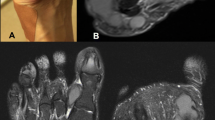Abstract
Chromoblastomycosis is a chronic subcutaneous mycosis caused by dematiaceous fungi. Fonsecaea monophora, a new species segregated from F. pedrosoi, may be the most prevalent pathogen of chromoblastomycosis in southern China. Herein, we report a rare case of chromoblastomycosis in a man with nephritic syndrome. He presented with an asymptomatic red plaque on the back of his left wrist that had appeared and enlarged over a period of 1.5 years, without any prior trauma. He was initially diagnosed with sporotrichosis. However, he did not respond to a 6-month course of potassium iodide treatment. The lesion slowly enlarged and became verrucous instead. Concurrently, a similar maculopapule appeared on his left forearm. Histopathological examination of a biopsy specimen indicated the presence of sclerotic bodies in the dermis. The fungus was identified as Fonsecaea spp. based on the results of a slide culture; in addition, the agent was confirmed to be F. monophora by using molecular methods. The patient demonstrated marked improvement after receiving appropriate antifungal therapy for 3 months. To our knowledge, this is the first case of chromoblastomycosis caused by F. monophora in an immunosuppressed patient. The identification of the agent by molecular techniques is important for epidemiological purposes. Thus, we believe that combination therapy with itraconazole and terbinafine would be a suitable option for infections caused by F. monophora.





Similar content being viewed by others
References
Mouchalouat Mde F, Gutierrez Galhardo MC, Zancopé-Oliveira RM, et al. Chromoblastomycosis: a clinical and molecular study of 18 cases in Rio de Janeiro, Brazil. Int J Dermatol. 2011;50:981–6.
Pérez-Blanco M, Hernández Valles R, García-Humbría L, et al. Chromoblastomycosis in children and adolescents in the endemic area of the Falcón State, Venezuela. Med Mycol. 2006;44:467–71.
Kondo M, Hiruma M, Nishioka Y, et al. A case of chromomycosis caused by Fonsecaea pedrosoi and a review of reported cases of dematiaceous fungal infection in Japan. Mycoses. 2005;48(3):221–5.
Verma S, Verma GK, Singh G, et al. Facial chromoblastomycosis in sub-Himalayan region misdiagnosed as cutaneous leishmaniasis: brief report and review of Indian literature. Dermatol Online J. 2012;18:3.
Hofmann H, Choi SM, Wilsmann-Theis D, et al. Invasive chromoblastomycosis and sinusitis due to Phialophora verrucosa in a child from northern Africa. Mycoses. 2005;48:456–61.
Lu S, Lu C, Zhang J. Chromoblastomycosis in Mainland China: a systematic review on clinical characteristics. Mycopathologia. 2013;175:489–95.
Azulay RD, Serruya J. Hematogenous dissemination in chromoblastomycosis. Report of a generalized case. Arch Dermatol. 1967;95:57–60.
Muhammed K, Nandakumar G, Asokan KK, et al. Lymphangitic chromoblastomycosis. Indian J Dermatol Venereol Leprol. 2006;72:443–5.
Sun J, Najafzadeh MJ, van den Ende AHG, et al. Molecular characterization of pathogenic members of the genus Fonsecaea using multilocus analysis. PLoS One. 2012;7:e41512.
De Hoog GS, Attili-Angelis D, Vicente VA, et al. Molecular ecology and pathogenic potential of Fonsecaea species. Med Mycol. 2004;42:405–16.
Surash S, Tyagi A, de Hoog GS, et al. Cerebral phaeohyphomycosis caused by Fonsecaea monophora. Med Mycol. 2005;43:465–72.
Takei H, Goodman JC, Powell SZ. Cerebral phaeohyphomycosis caused by ladophialophora bantiana and Fonsecaea monophora: report of three cases. Clin Neuropathol. 2007;26:21–7.
Yang YP, Li W, Huang WM, Zhou Y, Fan YM. Chromoblastomycosis caused by Fonsecaea: clinicopathology, susceptibility and molecular identification of seven consecutive cases in Southern China. Clin Microbiol Infect. 2013;19:1023–8.
Daboit TC, Magagnin CM, Heidrich D, et al. A case of relapsed chromoblastomycosis due to Fonsecaea monophora: antifungal susceptibility and phylogenetic analysis. Mycopathologia. 2013;176:139–44.
** L, Sun J, Lu C, et al. Molecular diversity of Fonsecaea (Chaetothyriales) causing chromoblastomycosis in southern China. Med Mycol. 2009;47:27–33.
Verma GK, Verma S, Singh G, et al. A case of extensive chromoblastomycosis from North India. Braz J Microbiol. 2014;45:275–7.
Bandyopadhyay A, Majumdar K, Gangopadhyay M, et al. Cutaneous chromoblastomycosis mimicking tuberculosis verrucosa cutis: look for copper pennies! Turk Patoloji Derg. 2013;. doi:10.5146/tjpath.2013.01197.
Pavithran K. Chromoblastomycosis masquerading as tuberculoid leprosy. Int J Lepr Other Mycobact Dis. 1992;60:657–8.
Roy AD, Das D, Deka M. Chromoblastomycosis-A clinical mimic of squamous carcinoma. Australas Med J. 2013;6:458–60.
Lakshmi TS, Rao G, Shekhar VA. Chromoblastomycosis masquerading as palmo-plantar psoriasis. Indian J Dermatol Venereol Leprol. 1999;65:83–4.
Torres-Guerrero E, Isa-Isa R, Isa M, et al. Chromoblastomycosis. Clin Dermatol. 2012;30:403–8.
Chavan SS, Reddy P. Cytological diagnosis of chromoblastomycosis. J Cytol. 2013;30:276–7.
Chavan SS, Kulkarni MH, Makannavar JH. ‘Unstained’ and ‘de stained’ sections in the diagnosis of chromoblastomycosis: a clinico-pathological study. Indian J Pathol Microbiol. 2010;53:666–71.
Najafzadeh MJ, Badali H, Illnait-Zaragozi MT, et al. In vitro activities of eight antifungal drugs against 55 clinical isolates of Fonsecaea spp. Antimicrob Agents Chemother. 2010;54:1636–8.
Daboit TC, Massotti Magagnin C, Heidrich D, et al. In vitro susceptibility of chromoblastomycosis agents to five antifungal drugs and to the combination of terbinafine and amphotericin B. Mycoses. 2014;57:116–20.
Bonifaz A, Saúl A, Paredes-Solis V, et al. Treatment of chromoblastomycosis with terbinafine: experience with four cases. J Dermatolog Treat. 2005;16(1):47–51.
Zhang J, ** L, Lu C, et al. Successful treatment for chromoblastomycosis caused by Fonsecaea monophora: a report of three cases in Guangdong. China Mycoses. 2009;52:176–81.
Zhang JM, ** LY, Zhang H, et al. Synergistic effects of terbinafine and itraconazole on clinical isolates of Fonsecaea monophora. Eur J Dermatol. 2009;19:451–5.
Acknowledgment
Funding Sources — The National Natural Science Foundation of China (No. 81271771).
Author information
Authors and Affiliations
Corresponding authors
Rights and permissions
About this article
Cite this article
Tan, H., Xu, Y., Lan, Xm. et al. Chromoblastomycosis Due to Fonsecaea monophora in a Man with Nephritic Syndrome. Mycopathologia 179, 447–452 (2015). https://doi.org/10.1007/s11046-014-9856-z
Received:
Accepted:
Published:
Issue Date:
DOI: https://doi.org/10.1007/s11046-014-9856-z




